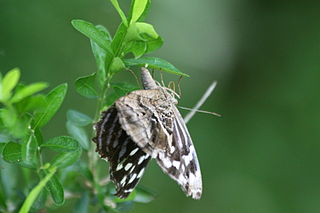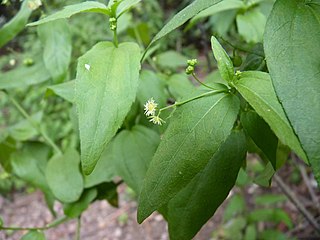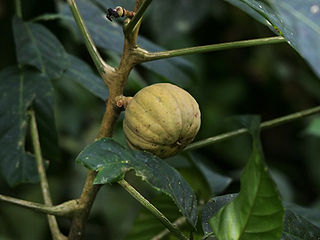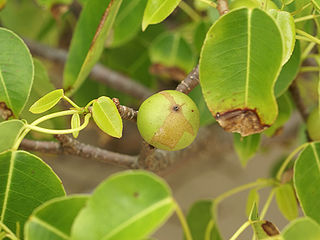
Sebastiania is a genus of flowering plants in the family Euphorbiaceae first described in 1821. It is native to North and South America from Arizona and the West Indies south to Uruguay.

Cnidoscolus is a plant genus of the family Euphorbiaceae first described as a genus in 1827. The group is widespread across much of North and South America, including the West Indies.
Dysopsis is a genus of plants in the family Euphorbiaceae, first described in 1858. It is the sole genus in subtribe Dysopsidinae. The genus is native to Costa Rica, Panama, South America, and the Juan Fernández Islands.
- Dysopsis glechomoides(A.Rich.) Müll.Arg. - Chile, S Argentina
- Dysopsis hirsuta(Müll.Arg.) Skottsb. - Juan Fernández Islands
- Dysopsis paucidentata(Müll.Arg.) Lozano & J.Murillo - Costa Rica, Panama, Colombia, Venezuela, Ecuador, Peru, Bolivia

Adelia is a genus of flowering plants in the spurge family, Euphorbiaceae, subfamily Acalyphoideae. It is native to Latin America and the Caribbean, with one species extending northward into the southernmost part of Texas.
Bernardia is a plant genus of the family Euphorbiaceae first described for modern science as a genus in 1754. It is native to North and South America, as well as the West Indies.

Alchorneopsis is a genus of flowering plants in the family Euphorbiaceae first described as a genus in 1865. It is native to Central America, the Greater Antilles, and northern South America.
- Alchorneopsis floribunda(Benth.) Müll.Arg. - Costa Rica, Honduras, Panama, Puerto Rico, Dominican Republic, 3 Guianas, Colombia, Venezuela, Ecuador, Peru, NW Brazil
- Alchorneopsis portoricensisUrb. - Puerto Rico
Caryodendron is a plant genus of the family Euphorbiaceae first described as a genus in 1860. The genus includes C. orinocense, known as the Inchi tree or Tacay nut. It is native to Central America and South America. They are dioecious trees.
- Caryodendron amazonicumDucke - Amazonas in Brazil
- Caryodendron angustifoliumStandl. - Costa Rica, Panama, Colombia
- Caryodendron janeirenseMüll.Arg. - Rio de Janeiro
- Caryodendron orinocenseH.Karst - Colombia, Venezuela, Ecuador

Caperonia is a genus of plants of the family Euphorbiaceae first described as a genus in 1825. The genus is native to tropical and subtropical America and Africa.

Chiropetalum is a plant genus of the family Euphorbiaceae first described as a genus in 1832. It is widespread across relatively dry regions of North and South America from Texas to Uruguay.

Ditaxis is a plant genus of the family Euphorbiaceae first described as a genus in 1824. Its name comes from Greek dis ("two") and taxis ("rank"), referring to the stamens which are in two whorls. The genus is widespread across much of the Western Hemisphere from the southern United States to Uruguay.

Tetrorchidium is a genus of flowering plants in the family Euphorbiaceae first described in 1841. It is native to tropical portions of Africa and the Western Hemisphere.

Dalechampia is a genus of plant of the family Euphorbiaceae and of the monogeneric subtribe Dalechampiinae. It is widespread across lowland tropical areas primarily in the Americas with smaller numbers of species in Africa, Madagascar, and southern Asia. Additional new species are still being described and several are very rare and at risk of extinction.

Hura is a genus of trees in the family Euphorbiaceae described by Carl Linnaeus in 1753. It is native to South America, Mesoamerica, and the West Indies.

Manihot is a genus in the diverse milkspurge family, Euphorbiaceae. It was described as a genus in 1754.
Acidocroton is a genus of plants under the family Euphorbiaceae first described with this name in 1859. It is native to Colombia and the Greater Antilles.
Dalembertia is a plant genus of the family Euphorbiaceae first described as a genus in 1858. It is native to Mexico and Guatemala.
- Dalembertia hahnianaBaill. - México State, Morelos, Michoacán
- Dalembertia platanoidesBaill. - Oaxaca, Guerrero, México State
- Dalembertia populifoliaBaill. - from Sonora to Oaxaca
- Dalembertia triangularisMüll.Arg. - Guatemala, Chiapas, Oaxaca

Gymnanthes is a genus of flowering plants in the spurge family, Euphorbiaceae first described as a genus in 1788. It is found primarily in the warmer parts of the Western Hemisphere, but with some species in central Africa and southwestern Southeast Asia.

Hippomane is a genus of plants in the Euphorbiaceae described by Linnaeus in 1753. It is native to the West Indies, Central America, Mexico, Florida, Venezuela, Colombia, and Galápagos.

Tetracoccus is a plant genus under the family Picrodendraceae. Shrubby-spurge is a common name for plants in this genus. They are dioecious, often hairy shrubs.

Pausandra is a plant genus of the family Euphorbiaceae first described in 1870. It is native to Central America and South America.
- Pausandra fordiiSecco - Amapá, French Guiana
- Pausandra hirsutaLanj. - Peru, Brazil, Bolivia (Pando), Colombia (Amazonas)
- Pausandra macropetalaDucke - Brazil, Peru (Loreto), Venezuela (Amazonas)
- Pausandra macrostachyaDucke - Pará
- Pausandra martiniBaill. - French Guiana, Suriname, Guyana, Colombia, Venezuela, Peru, Brazil
- Pausandra megalophyllaMüll.Arg. - Rio de Janeiro
- Pausandra morisiana(Casar.) Radlk. - Brazil
- Pausandra trianae(Müll.Arg.) Baill. - widespread from Honduras to Bolivia














